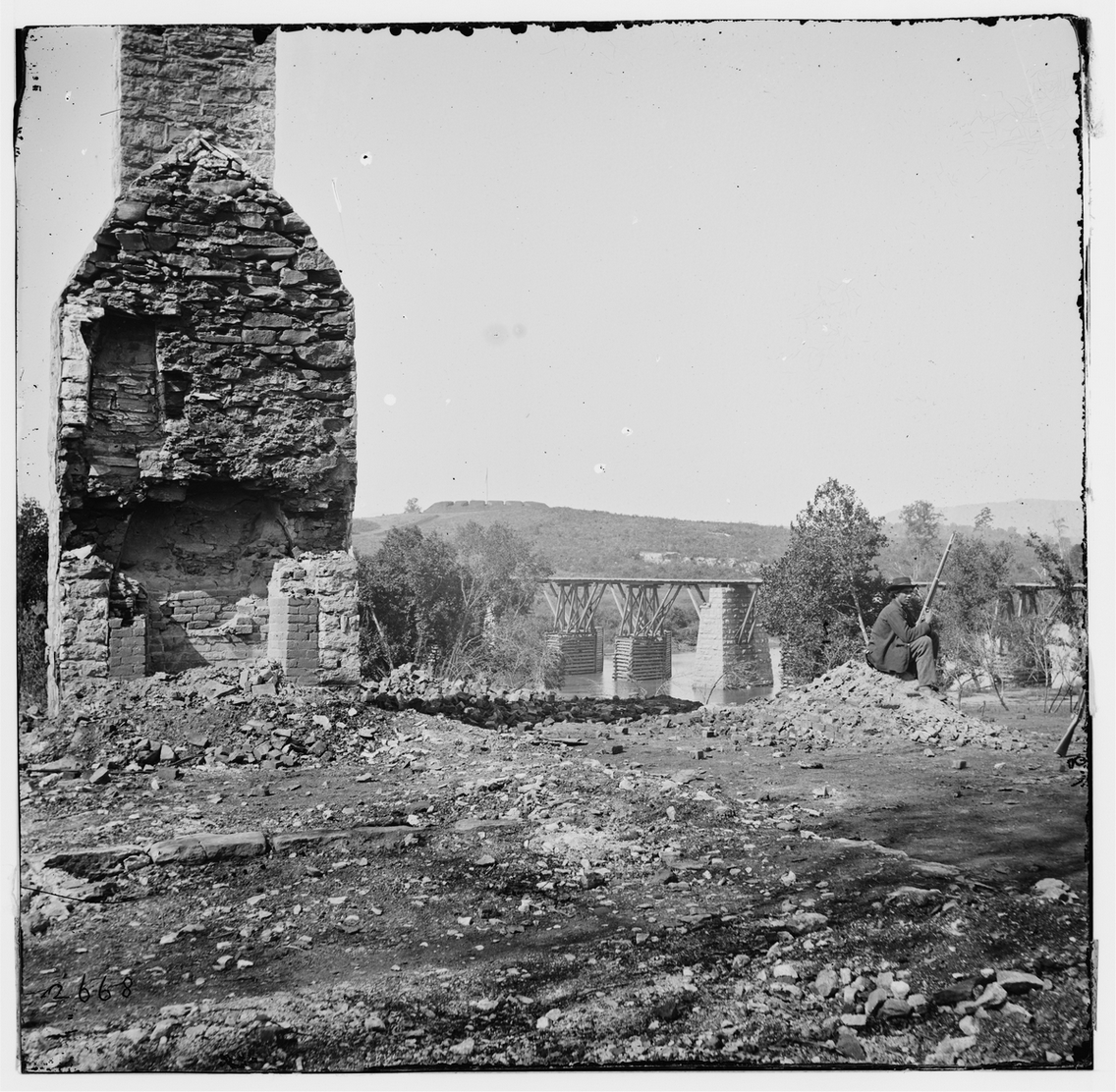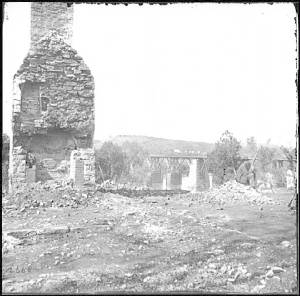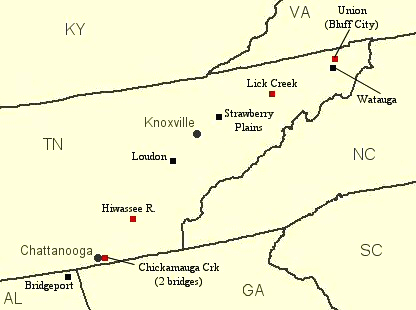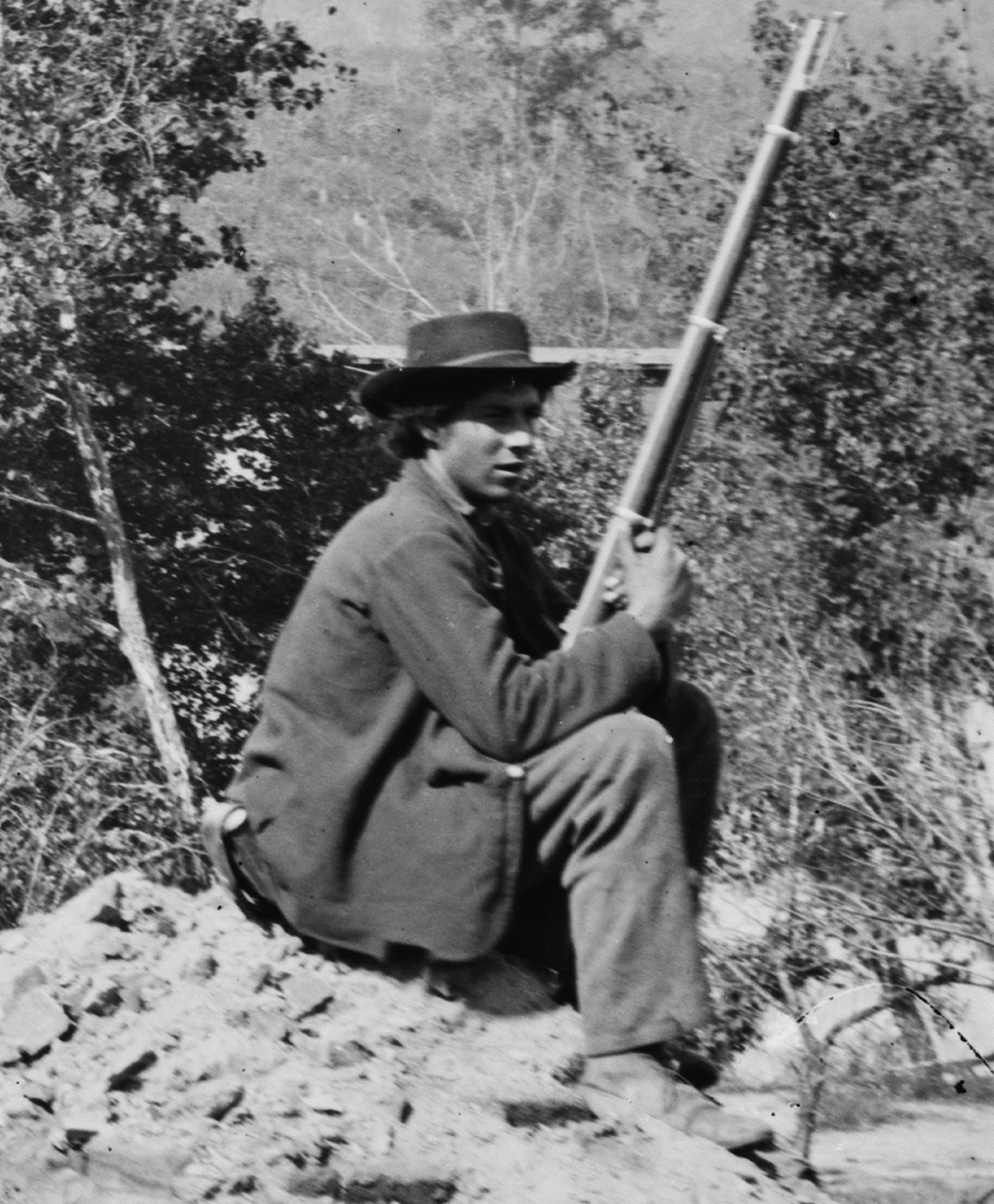|
Tennessee Civil War Battles
Railroads and Railroad Bridge Battle History
Introduction
Spanning the Holston River approximately 15 miles from Knoxville, the 1600-foot-long
Strawberry Plains Bridge was crucial to railroad transportation through East Tennessee during the Civil War. It escaped burning
on the night of November 8, 1861, when five of the nine bridges in the area were destroyed. Led by Union Colonel William P.
Sanders, a band of mounted infantrymen would eventually burn the bridge in June 1863, disrupting Confederate supply lines
in advance of the Army of the Ohio's move into East Tennessee.
| TN Civil War Railroad Bridge |

|
| Strawberry Plains Railroad Bridge on the Holston River |
(About the Photograph) Introduction: A George N. Barnard photograph
showing the railroad bridge over the Holston River at Strawberry Plains, Tennessee, with a Union sentry on the right, ruins
of a house on the left, and a fort in the background. Title: Knoxville, Tenn., vicinity. Military bridge at Strawberry
Plains and a fort in the distance, seen from north bank of the Holston. Date Created / Published: March 1864. Barnard,
George N., 1819-1902, photographer. Summary: Photograph of the War in the West. These photographs are of the Siege of Knoxville,
November-December 1863. The difficult strategic situation of the Federal armies after Chickamauga enabled Bragg to detach
a force under Longstreet which aimed to drive Burnside out of East Tennessee and did shut him up in Knoxville, which he defended
successfully. These views, taken after Longstreet's withdrawal on December 3, include one of Strawberry Plains, which was
on his line of retreat. Here we have part of an army record; Barnard was photographer of the chief engineer's office, Military
Division of the Mississippi, and his views were transmitted with the report of the chief engineer of Burnside's army, April
11, 1864. Reproduction Number: LC-DIG-cwpb-02145 (digital file from original neg. of left half) LC-DIG-cwpb-02146 (digital
file from original neg. of right half) LC-B8171-2668 (b&w film neg.). Source: Library of Congress. Notes: Unretouched
photograph was scanned for highest resolution at LOC by webmaster. It is perhaps the highest resolution of the event
now available online.
History
While guarding what was considered the most
important bridge in East Tennessee, Confederate Private James Keelan (also spelled Keeling) found himself in a life and
death fight as he engaged and repulsed a contingent of determined bridge burners.
Under a plan presented to President Lincoln
by Union Generals William Sherman and George Thomas, the nine bridges of East Tennessee would simultaneously be burned
during the guise of night on November 8, 1861. As five bridges were destroyed by Unionists, known as bridge burners,
four escaped the fate. Private James Keelan, Thomas' Legion, was 15 miles from Knoxville and guarding the mammoth 1,600-foot
Strawberry Plains Bridge on November 8, 1861, where he single-handedly met, fought, and repulsed
the determined saboteurs. Although Keelan was seriously wounded during the melee, the superstructure continued
to span handsomely across the splendid Holston River on the morning of the 9th. Keelan was posthumously awarded the rare Confederate Medal of Honor.
| Tennessee Civil War Railroad Map |

|
| East Tennessee Railroads and the Civil War |
| Strawberry Plains Bridge, Tenn. (ca 1860s) |

|
| Photograph Library of Congress |

(About) The nine bridges of East
Tennessee targeted by the bridge burners on the night of November 8, 1861. The red squares indicate bridges that were
successfully destroyed.
June 1863
Whereas the 1,600-foot Strawberry Plains Bridge stretched beyond the width of the Holston River, it would be destroyed on June 20, 1863. Because the bridge was the only structure supporting the rail
lines for the area, it was considered the most important bridge in East Tennessee, making it a priority target for Union forces. It exchanged betwixt the Union and Confederacy several times as one side would
destroy it and the other rebuilt it.
In Official Records of the Union and Confederate Armies, 23, I, p. 388, referring to the Strawberry Pains Bridge, Union Colonel William P. Sanders, Army of
the Ohio, reported that his army had "destroyed the splendid bridge over
the Holston River,
over 1,600 feet long, built on eleven piers. The trestle-work included, this bridge was 2,100 feet in length." Once destroyed, fellow General
Ambrose Burnside, a United States Military Academy graduate, pleasurably stated
that “It will take months to rebuild it." (Official Records of the Union and Confederate Armies, 23, I, 385.) See also Tennessee and American Civil War Railroads.
| Civil War soldier guarding bridge |

|
| High resolution photo of Union sentry guarding Strawberry Plains Bridge |
(About) High resolution photo of sentry at Strawberry Plains Bridge. This
photo is a close-up, cropped of course, of the Union guard as seen in the above photo. He is armed with the Springfield Model
1861 rifle-musket, the most widely circulated Union firearm of the time. Although slow to load with a rate-of-fire of 2
to 3 rounds per minute, this rifle, in the hands of an experienced soldier, could be effective to beyond 400 yards, or the
length of 4 football fields. Another reason for the rifle being preferred while guarding bridges
and depots, was that its effective range could pin down a raiding party while allowing nearby reinforcements to arrive. The
Confederate counterpart was armed with the Enfield Pattern 1853 rifle-musket, which was similar to the Model 1861 in
both range and rate-of-fire. Photo scanned at LOC by webmaster and is believed to be the highest resolution of the sentry
found anywhere online. See also Civil War Weapons.
Recommended Reading: Bridge Burners: A True Adventure of East Tennessee Underground Civil War.
Description: When the East Tennessee and Virginia Railway line was completed, dignitaries
gathered in celebration as the final spike was hammered into the last tie in Greene
County. Opening new doors of growth and economic development in the Region,
the railroad would become a point of conflict only three years later. When the Civil War began, the line became a vital link
in transporting Confederate troops and supplies into Virginia.
The railroad was vulnerable since many hostile Unionists remained in the region. Confederate authorities were understandably
worried about the rail lines and how to protect them. Continued below...
Inevitably the stage
was set and on a cold Friday night, November 8, 1861, the Unionists
proceeded with plans to burn the key railroad bridges of East Tennessee; President Abraham Lincoln had approved the plan. This thoroughly researched,
easy-to-read narrative tells the incredible true story of the people and events in the ‘insurrection gone wrong’.
Recommended Reading:
War at Every Door: Partisan Politics and Guerrilla Violence in East
Tennessee, 1860-1869. Description: One of the most divided regions of the Confederacy, East
Tennessee was the site of fierce Unionist resistance to secession, Confederate rule, and the Southern war effort.
It was also the scene of unrelenting 'irregular,' or guerrilla, warfare between Union and Confederate supporters, a conflict
that permanently altered the region's political, economic, and social landscape. In this study, Noel Fisher examines the military
and political struggle for control of East Tennessee from the secession crisis through the
early years of Reconstruction, focusing particularly on the military and political significance of the region's irregular
activity. Continued below...
Fisher portrays in grim detail the brutality and ruthlessness
employed not only by partisan bands but also by Confederate and Union troops under constant threat of guerrilla attack and government officials frustrated
by unstinting dissent. He demonstrates that, generally, guerrillas were neither the romantic, daring figures of Civil War
legend nor mere thieves and murderers, but rather were ordinary men and women who fought to live under a government of their
choice and to drive out those who did not share their views.
Recommended Reading: Valor
in Gray: The Recipients of the Confederate Medal of Honor. Description: Gregg
Clemmer writes in detail about the events that occurred that caused these men to be remembered. He has spent countless hours
researching the character of each recipient and their heroic-selfless actions. Includes the valorous actions of James
Keelen. Continued below...
Whether a descendant of the North or the South, this book will make you feel the emotion that drove these
men to risk their lives for their values and beliefs. Each chapter is devoted to a separate Confederate Medal of Honor recipient.
Valor in Gray is destined to be one of the best books on Civil War history.
Recommended
Reading: East
Tennessee and the Civil War (Hardcover: 588 pages). Description:
A solid social, political, and military history, this work gives light to the rise of the pro-Union and pro-Confederacy factions.
It explores the political developments and recounts in fine detail the military maneuvering and conflicts that occurred. Beginning
with a history of the state's first settlers, the author lays a strong foundation for understanding the values and beliefs
of East Tennesseans.
He examines the rise of abolition and secession, and then advances into the Civil War.
Early in the
conflict, Union sympathizers burned a number of railroad bridges, resulting in occupation by Confederate troops and abuses
upon the Unionists and their families. The author also documents in detail the ‘siege and relief’ of Knoxville.
Although authored by a Unionist, the work is objective in nature and fair in its treatment of the South and the Confederate
cause, and, complete with a comprehensive index, this work should be in every Civil War library.
Recommended Reading: Touring
the East Tennessee Backroads (Touring the Backroads) (380 pages) (John F Blair Pub; 2 edition) (October 1, 2007).
Description: The historical facts in the first edition of Touring the East Tennessee
Backroads have not changed much since the book was first published in 1993, but highway construction and development has altered
the routes of the 13 tours. For this second edition, the author drove over 3,000 miles to update the tours where people such
as Daniel Boone, Davy Crockett, Sam Houston, Andrew Jackson, Sequoyah, Nancy Ward, and Clarence Darrow once traveled the same
backroads.
Try the Search Engine for Related
Studies: Tennessee Civil War Battles, Railroad Bridge Burners, List of Tennessee Railroad Bridges Burned, The
Battle of Strawberry Plains Bridge Tennessee, Civil War Railroad History, Photo, Picture, Details, Facts
|

